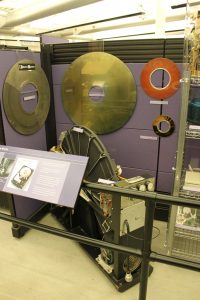Modern (1940’s-present)
38
Chandler Little
History of Computers
Modern technology first started evolving when electricity started to be used more often in everyday life. One of the biggest inventions in the 20th century was the computer, and it has gone through many changes and improvements since its creation. Computers in today’s society have become a focal point for everyday life and will continue to do so for the foreseeable future. During the evolution of computers, many people have helped with the creation and development, but some people’s contributions have been left out due to social status or lacking some credibility in the field.
Computers have come a long way from their creation. This first computer was created in 1822 by Charles Babbage. This computer was created with a series of vacuum tubes and weighed a total of 700 pounds, which is much larger than the computers we see today. For example, most laptops weigh in a range of two to eight pounds. A picture of one of the first computers can be seen below in figure 1. There have been large amounts of movement in the data storage sector in computers. The very first hard drive was created in 1956 and had a capacity of 5MB and weighed in at 550 pounds. Today hard drives are becoming smaller and we see them weighing a couple of ounces to a couple of pounds. As files have come more complex, the need for more space in computers has increased drastically. Today we see games take up to 100GB of storage. To give you a reference as to how big of a difference 5MB is to 100GB of storage is that 5MB is .005 GB. The hard drives we have today are seeing sizes from 10TB and larger. A TB is 1000GB. The evolution of the hard drive can be seen in figure 2. As the world of computers keeps progressing, there is a general concept of making them smaller, but at the same time seeing a generational step in improvement. With these large improvements, we see daily tasks from users like teachers, researchers, and doctors become shorter making their tasks quicker and easier to accomplish. With these great advancements in hardware, we are witnessing advancements in software as well. In software development, we are seeing strives in staying connected to others in the ways of social media, messaging platforms, and other means of communication. With all of these advancements in hardware and software, the hope is that we don’t become too reliant on computers. In the wake of a large power outage or an EMP attack, it could cripple our way of life.


The evolution of computers has been happening at a fast rate, and when this happens people’s contributions are left out. The main demographic in computers that are left out are women. Grace Hopper is one of the most influential people in the computer spectrum, but her work is not shown in the classroom. In the 1950s, Grace Hopper was a senior mathematician on her team for UNIVAC(UNIVersal Automatic Computing INC). Here she created the very first compiler (Cassel, 2016). This was a massive accomplishment for anyone in the field of computing because it allowed the idea that programming languages are not tied to a specific computer, but can be used on any computer. This single feature in computers was one of the main driving forces for computing to become so robust and powerful that it is today. Grace Hopper’s work needs to be talked about in classrooms not only just in engineering courses, but as well as general classes. Students need to hear that a woman was the driving force behind the evolution of computing. By talking about this, it may urge more women to join the computing field because right now only 25% of jobs in the computing sector are held by women (Cassel, 2016). With a more diverse workforce in computing, we can see the creation of new ideas and features that were never thought of before.
During the evolution of computers, many people have been left out with their creation with respect to the development and algorithms. With the push to gender equality in the world in future years, this gap between the disparity between women’s credibility and men’s credibility will be shrunk to a negligible amount. As computers continue to evolve the world of STS will need to evolve with them to adapt to the changes in technology. If not, some of the great creations in the computer sector will be neglected, and most notoriously here is VR (Virtual Reality) with its higher entry-level price and motion sickness that comes along with VR (Virtual Reality).
REFERENCES
Kleiman, K., About the author Kathy Kleiman is the founder of the ENIAC Programmers Project, & Saklayen, N. (2018, April 19). These 6 pioneering women helped create modern computers. ideas.ted.com. Retrieved September 26, 2021, from https://ideas.ted.com/how-i-discovered-six-pioneering-women-who-helped-create-modern-computers-and-why-we-should-never-forget-them /.
Lillian Cassel. “Op-Ed: 25 Years After Computing Pioneer Grace Hopper’ s Death, We Still Have Work to Do”. USNEWS.com, December 15, 2016 Thursday. advance-lexis-com.libproxy.clemson.edu/api/document?collection=news&id=urn:contentItem:5MDD-4VS1-JCKG-J4GB-00000-00&context= 1516831.
Thompson, C. (2019, June 1). The gendered history of human computers. Smithsonian.com. Retrieved September 26, 2021, from https://www.smithsonianmag.com/science-nature/history-human-computers-180972202/.
Zimmermann, K. A. (2017, September 7). History of computers: A brief timeline. LiveScience. Retrieved September 26, 2021, from https://www.livescience.com/20718-computer-history.html.
(May 26, 2017 Friday). Women in Computing and Women in Engineering honored for promoting girls in STEM. US Official News. https://advance-lexis-com.libproxy.clemson.edu/api/document?collection=news&id=urn:contentItem:5NMW-SXG1-DXCW-D04G-00000-00& context=1516831.
IMAGES
“Gene Amdahl’s first computer.” by Erik Pitti is licensed under CC BY 2.0
“First hard drives” by gabrielsaldana is licensed under CC BY 2.0
